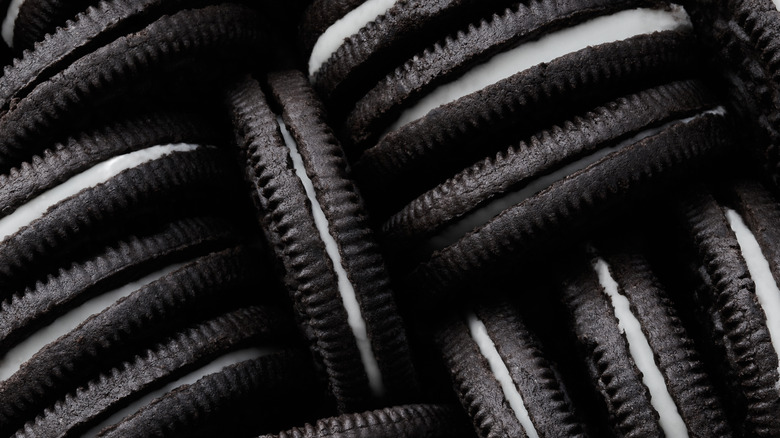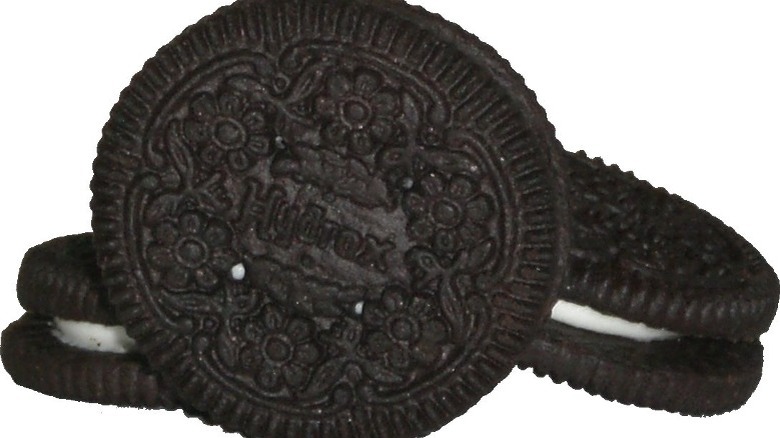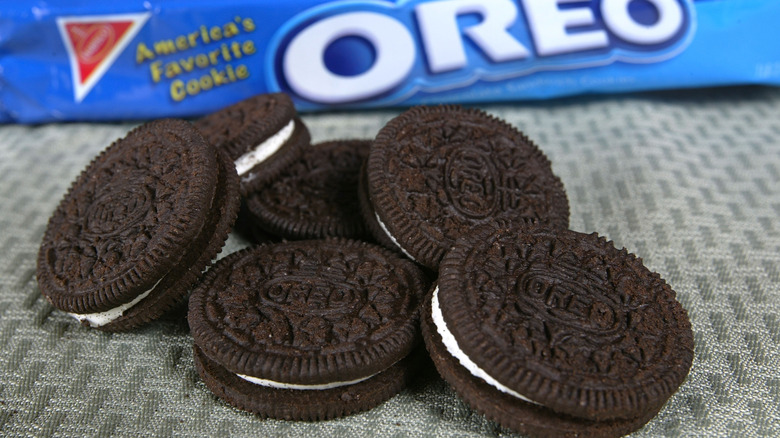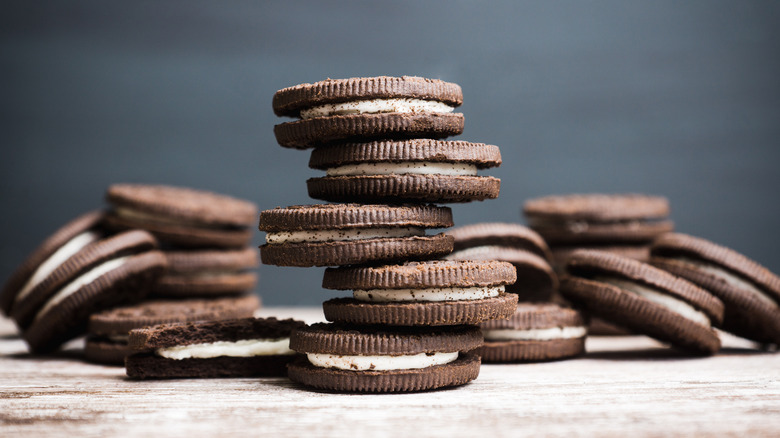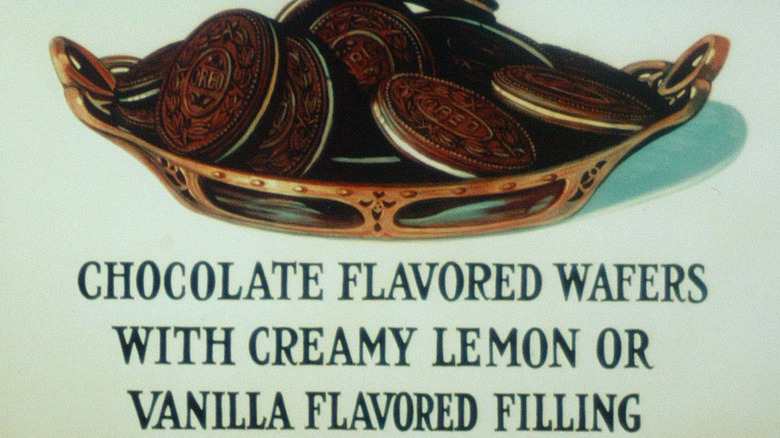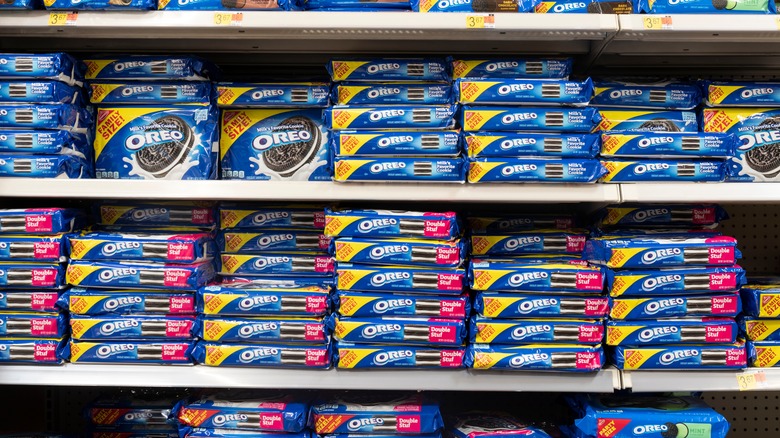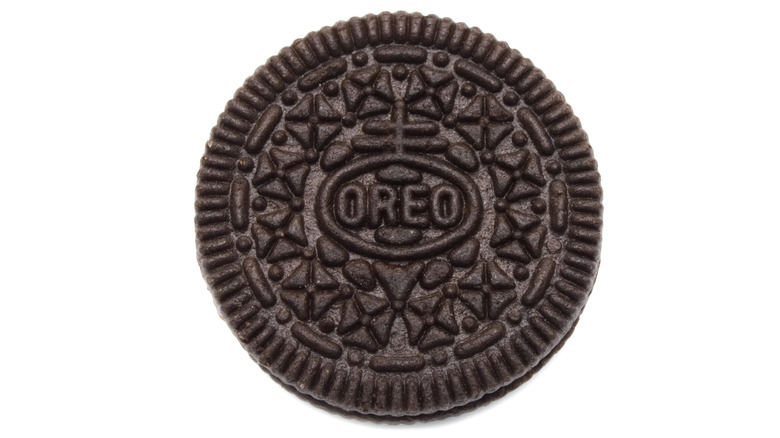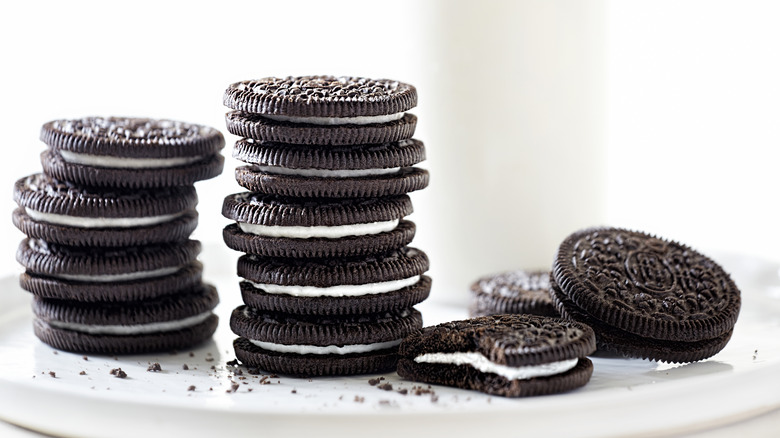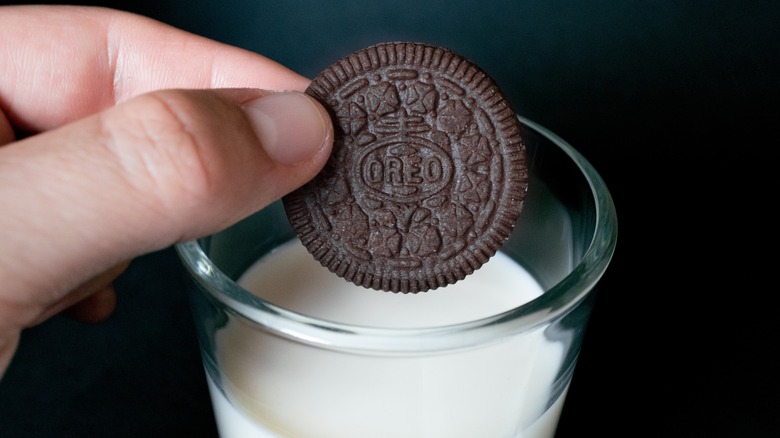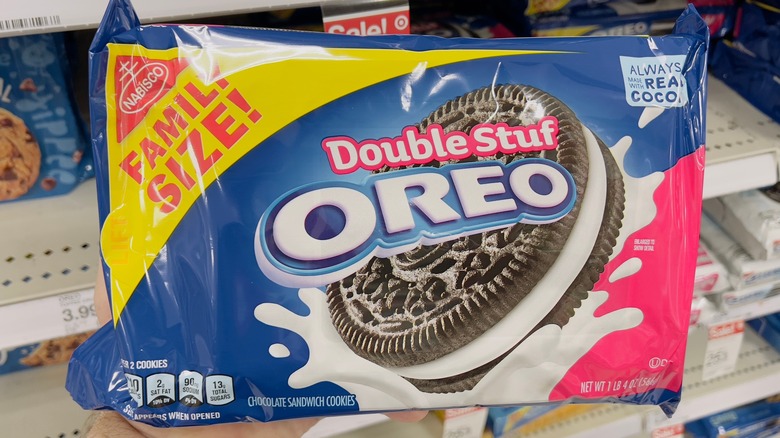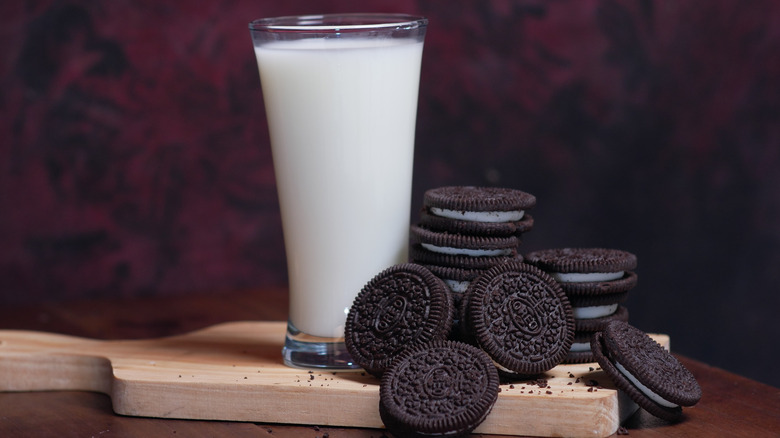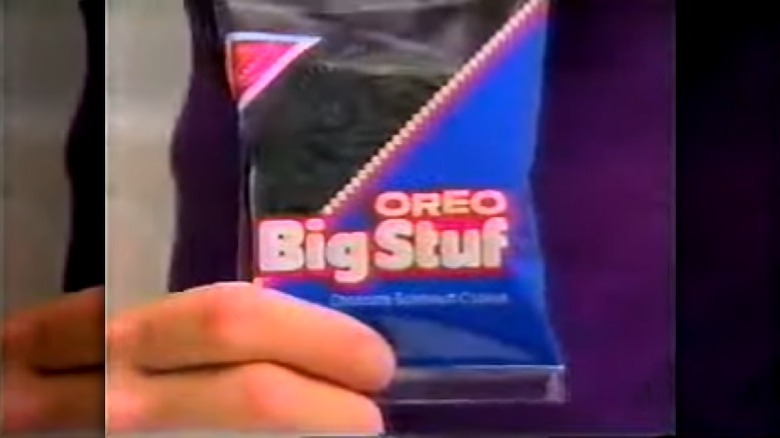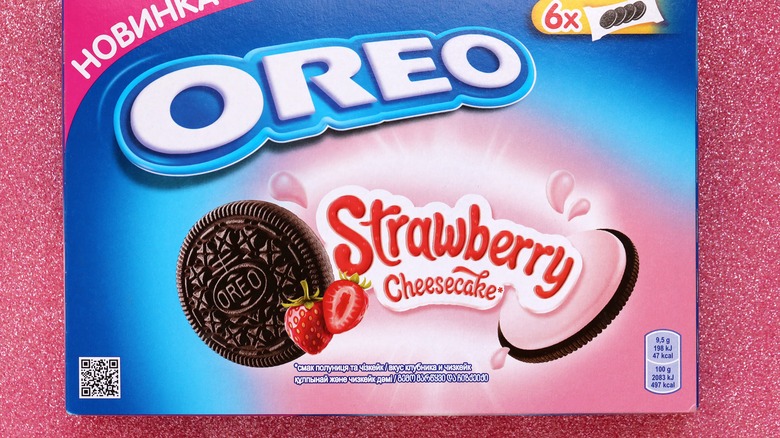13 Facts About Oreos Sandwich Cookies
There just can't be that many packaged sweet treats as popular or famous as the Oreo cookie. Part of the world's shared diet for more than 100 years, the American invention of the National Biscuit Company is a crowd-pleasing treat perfect for snacking, desserts, or being thrown into a lunchbox. Genius in its simplicity, an Oreo consists of two slightly sweet, very chocolatey, embossed, and thin wafer cookies and a pasty, creamy, powerfully sweet filling made from fat and sweetener. There's perfect balance in an Oreo, and they're great on their own or dipped in milk.
Billions of Oreos have been consumed since 1912, and they're as popular as they've ever been. They're a staple known around the world with a history as rich as their chocolate outsides and as sweet and worthy of savoring as their creamy insides. Pour yourself a tall glass of milk, grab two or three or six of those iconic sandwich cookies, and give these fascinating facts about Oreo cookies a dunk, twist, or bite.
1. Oreo is not the first sandwich cookie
Oreos are undeniably popular and almost universally known, but they're hardly original. Nabisco's signature cookie is more of a perfection of a recipe and concept introduced by a rival bakery earlier in the 20th century. According to Atlas Obscura, Sunshine Biscuits introduced Hydrox Biscuits in 1908 — chocolate wafers with a creamy filling in the middle. That name sounds so unappetizing and scientific because it is scientific — "Hydrox" is a portmanteau of "hydrogen" and "oxygen," the components of water, and producers were trying to suggest to consumers that the cookies were clean during a time where food purity scandals were so rampant that the government had recently established the FDA to regulate the industry.
Hydrox may also conjure to consumers hydrogen peroxide, and a producer of the stuff, the Hydrox Chemical Company, sued Sunshine Biscuits for name infringement. The cookie bakers were allowed to continue on, however, and Sunshine still makes Hydrox cookies to this day, with sales far behind those of Oreo because they appeal to a narrower audience. Hydrox cookies are kosher, with the wafers a little bit more bitter and the filling less sweet than the stuff in the middle of an Oreo, first sold in 1912 — four years after Hydrox hit stores.
[Image by Spacefem via Wikimedia Commons | Cropped and scaled | CC BY-SA 3.0]
2. Oreos have had a few different names
Oreos haven't always been "Oreos." According to contemporary producer Mondelēz International, the cream-filled chocolate treat was made at the Chelsea Market Bakery in New York City and first sold in 1912 under the name "Oreo Biscuit," packed into gold tins and distributed to grocers who sold them as a bulk item. In 1921, the National Biscuit Company changed course, dropping "biscuit," the still-common British term for cookie (per Vox), and repackaged Oreos in direct-to-consumer boxes with the name "Oreo Sandwich." Box copy gave a full description of the product inside: "two chocolate wafers with a rich creamy filling."
Sixteen years later, the National Biscuit Company changed course again, inserting the fancy-sounding "creme" into the name of the cookie itself, rebranded as "Oreo Creme Sandwich." Today, they're officially known as the "Oreo Chocolate Sandwich Cookie," but most people just say "Oreo" or "Oreos."
3. No one's sure why they're called Oreos
Despite all that aggressive name-changing, it's either lost to history or a well-guarded company secret as to exactly why the sandwich cookie was ever named something revolving around "Oreo" in the first place. Food historians have some theories, according to Time, like how "Oreo" sort of sounds like "or," the French word for gold, the color of the tins into which Oreos were once packaged.
According to Stella Parks' "BraveTart: Iconic American Desserts," the National Biscuit Company of the 1910s released Oreos as part of a product line with plant-derived names. At the time, Nabisco's offerings included Avena, Lotus, Zephyrette, Zaytona, Anola, and Ramona, in addition to Oreo. Parks explained that the name of the cookie might be a nod to the product's flowery etched design, an element creators lifted along with most everything else from the Hydrox cookie. Those Oreo predecessors feature a design that depicts a mountain-growing plant called the oreodaphne.
4. Oreo outlasted its sibling cookies
The National Biscuit Company didn't send cream-filled chocolate sandwich cookies called Oreos out into the packaged foods landscape all on their own in the spring of 1912. (Consequently, "National Oreo Cookie Day" is celebrated around that time each year, on March 6.) Initially, according to Sherri Liberman's "American Food by the Decades," Oreo was available in two flavors: the chocolate with the creamy filling, and a cookie that emulated lemon meringue pie. The chocolate variety proved to be overwhelmingly the better seller, and the National Biscuit Company ended production on the lemon meringue Oreo in 1924.
Alongside its two-pronged Oreo push, the company that would later be known as Nabisco released two other cookies to stores at the same time, according to Atlas Obscura, both quickly discontinued and now long forgotten. Nabisco's paperwork with the U.S. Patent and Trademark Office (via "Food History Almanac") shows that Oreo was the most expensive (at 30 cents per pound) of a trio of cookies marketed as "The Trio." There also existed the Mother Goose Biscuit, which Nabisco called "a rich, high class biscuit bearing impressions of the Mother Goose legends," and the Veronese Biscuit, "a delicious, hard sweet biscuit of beautiful design." The latter two both cost 20 cents a pound.
5. A staggering number of Oreos are produced and eaten each year
Oreo falls under the purview of global food producer and distributor Mondelēz International. Demand for Oreos is so substantial that the company operates cookie-producing factories in 18 different countries. Altogether, Mondelēz makes roughly 40 billion Oreo cookies in a year, enough to circle the planet five times, or enough to give every person on Earth about five cookies. According to a 2023 press release from Mondelēz (via PR Newswire), about one third of all Oreos consumed are eaten in the United States. And in the century-plus since Oreos made their debut as a product of the National Biscuit Company, about 500 billion cookies have been gobbled up.
According to statistics compiled by Quartz, Oreo is far and away the best-selling cookie brand on the planet. In 2014 alone, Oreo generated more revenue than Chips Ahoy!, Keebler, Little Debbie, and Girl Scout Cookies did combined.
6. It takes hours to make a single Oreo
An Oreo may look like a simple creation — it's just a couple of chocolate crunchy cookie pieces and some creamy, sugary paste; how complicated could it be? Plenty complicated, it would seem. It takes a lot of finesse and the perfect technique and conditions to get the cookies and the cream both at the right consistency. According to the New York Times, as of 1986, Oreos began their journey in a mixing vat the size of a small car where the ingredients were mixed for half an hour. Then the product hit a conveyor belt for 20 minutes, where it was pressed into that familiar round shape before proceeding onto ovens and cooling chambers. One machine added the cream filling, and another packaged them. Altogether, the process described by NYT took a little under an hour. However, in 2019, manufacturer Mondelēz International stated that the timing is closer to two hours.
It takes so long to get an Oreo correct because millions of consumers have to come to expect a certain level of quality, while the manufacturer also has to nail the ratio of ingredients for everything to work correctly. According to Food World News, each standard, regular-size Oreo cookie consists of 71% cookie wafer and 29% sweet cream filling.
7. Oreos aren't vegan
Oreo predecessor Hydrox is a kosher product. That's important, considering that for eight decades, Oreos weren't kosher. They were made with pork lard, a food not allowed under Jewish dietary law, according to the Cornell Chronicle. Oreos weren't kosher until 1997, following a three-year period in which Nabisco reformulated the cookie to use plant-based fats instead of an animal-derived one, got its manufacturing systems up to speed, and received kosher certification.
Jewish people who abide by the kosher guidelines aren't the only consumers who avoid pork, though — vegans eschew it, too. Oreo cookies were now kosher, but are they vegan? According to VegNews and other sources, it appears that the popular sandwich cookie is animal product-free, because nothing on the product label comes from anything with a face. But according to the Oreo U.K. website, the cookies are appropriate for a vegetarian diet (because they don't contain meat) but possibly not for a vegan diet — in the production process, there's a chance of Oreos becoming cross-contaminated with dairy products. In 2010, vegan issues blog My Face is on Fire printed an excerpt of an email response from Kraft (at the time the parent company of Oreo maker Nabisco) suggesting that some of the sugar used to make the cookies may occasionally be laced with bone char, a refining substance made from animal bones. According to animal rights organization PETA, standard Oreo sandwich cookies aren't a vegan food, but the cream filling-free 100 Calorie Thin Crips are fair game.
8. Lots of people eat Oreos in a lot of different ways
There's more than one way to eat an Oreo. Some people go all in and take a big bite straightaway, others twist off the top chocolate wafer and scrape off the cream with their teeth, and others go the milk-and-cookies route and dunk their Oreo until it's good and soggy. In 2004, Kraft Foods commissioned a survey regarding Oreo consumption habits. The company questioned 2,000 people about exactly how they eat their Oreo cookies. The findings, according to the Spartanburg Herald-Journal: Biting is the most popular Oreo eating method, with 45% of respondents claiming that route. An additional 22% like to get things started by twisting off one wafer, while 20% begin the treat-eating ritual by dipping the whole cookie in milk.
Gender may even be a predictor in Oreo behavior. According to CBS News, Kraft conducted another study in 2012 to celebrate the 100th anniversary of Oreo and found that women were more likely than men to be cookie twisters.
9. Double Stuf Oreos aren't truly twice as stuffed
According to Oreo parent company Mondelēz International, the first major brand extension of the cookie hit the market in 1974, 50 years after the retirement of the lemon meringue variety. That new Oreo style, arriving in pink packaging to distinguish itself from original Oreo blue: Double Stuf. Each cookie's middle is visibly extra large, with a lot of extra cram filling included. The name would strongly imply that a Double Stuf Oreo contains double the "stuff" found in a traditional Oreo, but that's actually something of a fib and an exaggeration.
Nobody apparently checked on the double stuff in Double Stuf claim until 2013, when math teacher Dan Anderson performed the calculations. As an experiment for his math blog A Recursive Process, Anderson weighed 10 Oreos, 10 Double Stuf Oreos, 10 Mega Stuf Oreos, and five plain Oreo chocolate wafers and then did some simple calculations to determine the exact weight of the creamy filling in each Oreo style. The results: A Double Stuf Oreo contains 1.86 times as much filling as a standard Oreo. (Mega Stuff Oreos, for what it's worth, pack 2.68 times as much white stuff as original Oreos.)
10. Oreo set a new world record for cookie dunking
Shortly after announcing that it had sold $3.1 billion worth of Oreo products in the previous year, the cookie's distributor, Mondelēz International, decided to celebrate and promote that fact by setting some world records involving that beloved treat. According to Guinness World Records, on January 30, 2020, the company set a new benchmark in "most people dunking cookies simultaneously." Mondelēz employees from 32 countries gathered at 55 spots around the world, and all at once, 5,066 people dunked their assigned Oreo into a glass of milk — surely a nod to Oreo's marketing and packaging slogan, "Milk's Favorite Cookie."
Mondelēz loves to quirkily promote its valuable asset with attention-getting, record-breaking stunts. In April 2018, the company opened an Oreo production facility in Bahrain, and, in celebration, built the largest-cream filled biscuit the world has ever seen. That massive Oreo was made with real Oreo ingredients and weighed 161 pounds, 13 ounces — roughly the size of 6,500 standard Oreo cookies.
11. Oreos were involved in the world's largest blind taste test
The distinctive flavor and mouthfeel of an Oreo — a combination of taste, texture, and the interplay of chocolate and cream — are extremely familiar to tens of millions of people. In a 2009 publicity and promotional stunt, Nabisco decided to test just how well known those attributes were, according to Guinness World Records. In June 20, 2009, exactly 1,471 people attended an Oreo-sponsored event in Madrid, Spain, which doubled as an attempt to set a new world record for "largest blind taste test."
All attendees were blindfolded and then given two chocolate-and-cream sandwich cookies, one an authentic Oreo, the other made by some other cookie company. After submitting to the data-gathering Oreo-eating ritual of twisting open the cookie, licking out the cream, and then dunking the chocolate cookie wafers in milk, attendees had to guess which cookie was a real-deal Oreo and which one wasn't. Plenty of people guessed correctly while also claiming partial credit for a new Guinness world record.
12. Not every Oreo product is a hit
Oreo isn't just a chocolate sandwich cookie; it's a household name and a viable brand. Beyond Oreo extensions like the Double Stuf and Mega Stuf, those omnipresent cookies are an ingredient or flavor in a number of successful products, from ice cream to ice cream cones to candy bars. But not every Oreo item has been a success. In 1984, according to FastCompany, Nabisco introduced the Oreo Big Stuf — a massively super-sized Oreo roughly 10 times larger than a standard cookie. Each was packaged individually and designed for on-the-go snacking and packed more than 300 calories. It stuck around stores for seven years before discontinuation.
Food scientists working in the Oreo milieu would think big and with lots of imagination. Oreo Magic Dunkers began their brief existence in 2000. When dipped in milk, according to Mental Floss, they made the liquid turn blue. Six years later, Nabisco unveiled Oreo Dunkers — oval-shaped Oreos that could be more easily dipped into even the most narrow of glasses of milk.
13. Why there are so many wacky Oreo flavors
According to Teen Vogue, more than 50 flavor variations of Oreos had popped up on grocery store shelves as of 2017. Seemingly nothing sweet is outside of the realm of possibility for Oreo's imaginative flavor developers, who have foisted varieties like Watermelon, Red Velvet, Pumpkin Spice, Coconut, Creamsicle, DQ Blizzard, Caramel Apple, Fruity Crisp, Waffles and Syrup, Fruit Punch, Candy Corn, and Swedish Fish unto the public, who was previously just fine with the century-old chocolate-and-cream filling version.
It's not that Oreo and its corporate partners at Mondelēz International are trying to corner the world cookie market by offering every possible Oreo take. It's actually a sophisticated and complicated marketing push for original, traditional Oreos. "The key is they're not trying to introduce the flavors for long-term consumption. You build in this idea of really tacky flavors, and that sort of builds this relationship to the consumer who likes to sort of check out these kitschy Oreos," Cornell University behavioral economist David Just told GQ. Odd flavors then generate social media chatter among younger consumers, which all builds brand awareness, familiarity, and loyalty. Oreo establishes a distinctive "personality behind its brand," Just explained, thus separating it apart from the competition.
